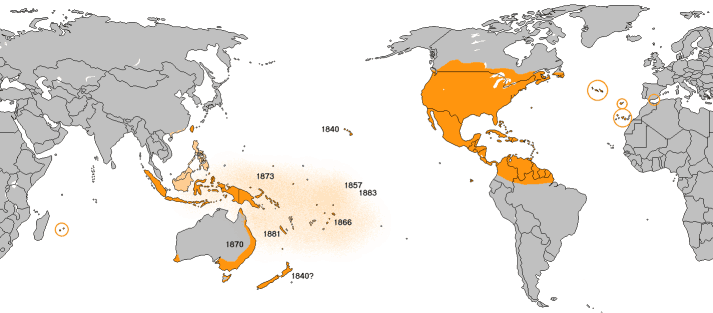If you live in the United States or Canada, you’ve probably read or heard news stories about the drastic decline in Monarch butterflies migrating to Mexico in the fall. After reading some of those articles, I started to get interested in finding out what I could do to help increase the numbers of Monarchs that migrated. As I was researching, I came across several migration maps that showed the migratory patterns of the Monarchs from Mexico throughout the United States (east of the Rocky Mountains) and into southern Canada. So I assumed that the Monarch butterfly primarily lived in the United States and Canada. As I continued to research Monarchs, I found that North America is not the only place that they live.
So where do Monarch Butterflies live? They live in North America (Canada, Mexico, United States, the Caribbean Islands), Central America (Belize, Costa Rica, El Salvador, Guatemala, Honduras, Nicarargua, Panama), South America (Argentina, Bolivia, Brazil, Chile, Columbia, Ecuador, Guyana, Paraguay, Peru, Suriname, Uruguay, Venezuela), Australia, the Pacific Islands, Africa (Morocco, the Canary Islands, Madeira Island), Europe (England, Portugal, Scotland, Spain, Wales, the Azores Islands).

Marcus Kronforst, an evolutionary biologist, and a team from the University of Chicago sequenced genomes taken from Monarch populations from around the world. Evolutionary biologists study the way in which life on Earth has evolved and how organisms interact. What Dr. Kronforst and his team was trying to figure out was where the Monarch butterfly originated. Through their research they found that the Monarch got its start in North America and later, three additional branches emerged in the North American Monarch’s evolutionary tree; one in Central and South America, one in the Pacific, and one across the Atlantic.
North America
In North America, Monarch butterflies can be found throughout the United States (including Hawaii), southern Canada and Mexico, and the Caribbean. There are actually 2 separate populations of Monarchs in North America, separated by the Rocky Mountains. The Monarchs that live to east of the Rockies are the eastern population and those living to the west of the mountains are considered the western population. While we’ve heard the news reports of the declining number of Monarchs migrating to Mexico, it is important to note that the western population of the North American Monarchs do not migrate to Mexico at all. Instead, they migrate to central and southern California, primarily along the coastline. The eastern population is by far the largest population in Northern America, accounting for over 98 percent of the Monarchs in all of North America. The western Monarch population is a tiny fraction of all North American Monarchs. Based on the Xerces Society’s 2018 Thanksgiving count, there were only 28,429 Monarchs in the western population. This is especially concerning because it is believed that 30,000 is the threshold that needs to be maintained in order to avoid extinction.
Sometime during the mid 1800s, the milkweed plant was introduced to the Hawaiian islands and shortly after the Monarch somehow found its way to the islands. To paraphrase the iconic line from “Field of Dreams”, “plant it and they will come”. The white morph Monarch butterfly is more frequently seen on the Hawaiian island of Oahu. The white morph Monarch looks similar to the regular Monarch butterfly, except that it is white instead of orange. It is believed that this white mutation occurred as a survival mechanism. In 1965 and 1966 two bulbul species of birds were introduced to the island, and have become the most common insectivore birds on the island. These birds prey on insects including the Monarch. For whatever reason, the bulbuls do not go after the white morph Monarchs; only the regular orange ones. Monarchs living on Hawaii do not migrate. The temperatures on the islands don’t get cold enough for them to need to migrate. The lowest average monthly temperature in Honolulu is around 65° Fahrenheit in February. Monarch butterflies can’t fly in temperatures below about 55° Fahrenheit.
In Canada, Monarchs are primarily found in southern parts of the country. Milkweed doesn’t typically grow too far north of the United States / Canadian border, but if you live in southern parts of Alberta, British Columbia, Manitoba, Ontario, Quebec, or Saskatchewan, you should be able to find Monarchs. They are most abundant in Ontario and Quebec.
From their research conducted at the University of Chicago, Dr. Kronforst and his colleagues found that while the Monarch originated in North America, it spread from the southern United States and northern Mexico south into Belize and Costa Rica, and then into South America and the Caribbean.
Central America
In Central America, the Monarch butterfly can be found in all 7 countries: Belize, Costa Rica, El Salvador, Guatemala, Honduras, Nicaragua, and Panama. Unlike the North American Monarchs that migrate from the north to the south (up to 3,000 miles), Monarchs in Central America only need to migrate up to 60 miles. And they don’t migrate for temperature reasons like they do in the US and Canada. Instead, they migrate because of seasonal dry and wet conditions.
South America
In South America, there are actually two species of Monarchs. The North American Monarch (danaus plexippus) can be found in far northern part of the continent, in Columbia, Ecuador, Guyana, Peru, Suriname, and Venezuela. The Southern Monarch (danaus erippus) can be found in Argentina, Bolivia, Brazil, Chile, Paraguay, Peru, and Uruguay.
It’s important to note that while the Southern Monarch’s genome is almost identical to the North American Monarch, the two are incompatible. The Southern Monarch’s migratory pattern appears to be the same as the North American Monarch. They have been observed flying south in the fall, which is interesting. In North America, the Monarchs migrate south in the fall towards the warmer temperatures of Mexico (eastern population) and central and southern California (western population). But in South America, by flying south in fall, they are migrating towards colder temperatures.
Australia
It is believed that Monarch butterflies arrived in Australia sometime in the mid 1800s, but nobody seems to know how they got there. One theory is that because of the increased travel between Australia and California during the Gold Rush (1848-1855), a Monarch might have hitched a ride back to Australia. Another theory is that Monarchs were already populating New Caledonia and that heavy winds or storms might have blown them west to Australia.
Pacific Islands
I have not been able to find information on exactly how the Monarch managed to get to the Pacific Islands from North America. I’m not sure anyone knows. The only thing I could find was that Monarchs found there way there either accidentally, deliberately, or on their own in the mid 1800s. I wonder if they arrived in Australia first (as mentioned above) and then spread out to the various islands.
There is somewhere in the neighborhood of 25,000 islands in the Pacific Ocean and the islands are divided into 3 main groups: Melanesia, Micronesia, and Polynesia.
The main island groups of Melanesia are Fiji, New Caledonia, Papua New Guinea, the Solomon Islands, Vanuatu, and from what I found, it looks like the Monarch lives on all of those main islands with the exception of Vanuatu. It’s possible that the Monarch does live on Vanuatu, but I was unable to find any information on it.
Micronesia has 4 main island groups: the Caroline Islands, the Gilbert Islands, the Mariana Islands, and the Marshall Islands. I have found references to the Monarch in the Mariana Islands and the Marshall Islands, but was unable to find anything about the Caroline or Gilberts Islands. Again, it doesn’t mean that the Monarch isn’t there, I just could find any documentation to know for sure.
Among the Polynesian islands, I found that there are Monarchs living on Cook Islands, French Polynesia, Hawaii, New Zealand, Norfolk Island, Samoa, Tonga, Tuvalu, and Wallis and Futuna.
Africa
Believe it or not, the North American Monarch, danaus plexippus, can also be found all the way across the Atlantic Ocean in Africa, although sightings have been limited to the coast of Morocco, the Canary Islands, and Madeira.
Europe
Also across the Atlantic, the North American Monarch can be found in England, Portugal, Scotland, Spain, Wales, and the Azores Islands.
In the United Kingdom, the North American Monarch has been spotted in England, Scotland, and Wales, although the number of sightings is usually pretty small (less than 500) and usually in the western coastal areas of the UK. Some people believe that the Monarchs in the UK are blown across the Atlantic Ocean from the US and Canada. Milkweed does not grow natively in the UK so those Monarchs that wind up there would be unable to reproduce. Female Monarch butterflies will only lay their eggs on milkweed plants because that is the only plant that the caterpillars can eat.
The Monarch has been able to colonize in Portugal, Spain, and the Azores Islands, as long as there is milkweed available.
In Summary
Although the Monarch may have originated in North America, it has managed to find its way to other continents, and in some cases traveled thousands of miles across oceans to get there. The Monarch is sometimes referred to as the Wanderer butterfly. Now I know why.
